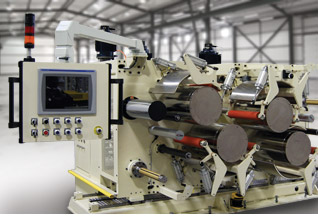

September 10 2018

Machine Direction Orienters (MDOs) are relatively straight forward devices. Their primary function is to induce orientation in the polymer structure of plastic film or sheet in the machine direction by stretching it longitudinally at optimal process temperature. This results in down-gauging a film’s thickness while retaining or improving its physical properties. The process may also be used to modify performance characteristics such as tensile strength, modulus, elongation, clarity, haze, shrinkage, oxygen barrier, water vapor barrier, porosity, and so on. However, just how these characteristics will be affected by orientation will depend on the polymer and overall formulation of the precursor sheet in addition to the conditions at which the material is processed.
As mentioned previously in Part 1, to orient material we need to heat and apply a longitudinal stretching force using a series of rollers running at increasing surface speeds. Depending on the application, the MDO will be designed using a single or multi-stage stretching section. These configurations simply refer to the number of draw rollers used in the stretching process. A single-stage machine employing one pair of draw rollers generally would be less expensive than a multi-stage machine employing additional draw rollers, but a multi-stage machine may enable the product to run faster and provide more output. However, it’s never that straight forward.
So, which configuration would work best? Does your application require an MDO that utilizes a single-stage or multi-stage configuration?
Before we dive into these questions, we need to first understand the critical process conditions: mainly how the stretch rate, stretch ratio, and the line speed influence one another and ultimately affect the results of the material being oriented.
The stretch ratio needed for any given application is typically fixed over a narrow range and dependent primarily on the general family of polymer being used. The strain rate is often a limiting factor as many materials will have an upper limit after which it will tend to break rather than stretch. So, the overall process line speed will be limited by the combination of stretch ratio and strain rate due to the interdependence of these process conditions.
It’s impossible to explain how all materials will perform in a single or multi-stage process in just one article. However, a good rule of thumb is that for applications were the stretch ratio and/or line speed are relatively low, single-stage machines are often adequate. Also, for unique applications where a high strain rate is desirable (for example, PTFE), single-stage machines are preferred. However, for applications running at high speeds and/or where the strain rate needs to be limited (such as the MDO for a BOPP line), multi-stage stretching will be needed.
Another benefit of a multi-stage stretching configuration is that it makes any given MDO more versatile giving you the flexibility to run a wider range of materials and process conditions. This can be useful in situations where there is uncertainty in either the process conditions or the range of products you will run on the MDO during its useful life.
We haven’t even touched upon how all material can be affected by the temperature, not to mention the unforeseen primary and secondary effects that can occur. This will be discussed in the next article.